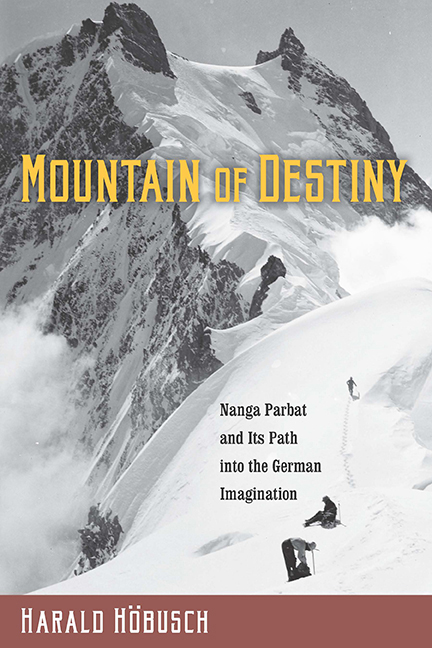5 - Hiding the Obvious
from Part III - Imag(in)ing the German “Mountain of Destiny”
Published online by Cambridge University Press: 05 July 2016
Summary
politically valuable, culturally valuable, educational
—Rating given to Nanga Parbat: Ein Kampfbericht der Deutschen Himalaja Expedition 1934 by the ReichsfilmkammerIN 1997/98 THE MUNICH FILM MUSEUM, as part of its retrospective of films by the “father” of the German Bergfilm, Dr. Arnold Fanck, presented a rarely screened 1935 feature directed by Andrew (Endré) Marton (1904–92) titled Der Dämon des Himalaya, a film that at the time was lauded as one of the best mountain films ever made and to this day occupies a singular position within this particular film genre. For one, Der Dämon des Himalaya literally takes the Bergfilm to new heights; it remains the only feature film ever produced directly in the Himalaya at altitudes reaching up to 6,400 meters, exposing actors and film crew alike to an environment that is usually reserved for experienced mountaineers and depicted solely in documentary or expedition films. More importantly, however, Marton's Der Dämon des Himalaya marks the first film released in Germany after the National Socialist rise to power in 1933 that depicts—albeit in fictional form—the challenges faced by— and ultimate fate of—an expedition to the highest mountain range in the world, the Himalaya. Premiering at a time of almost obsessive fascination in Germany with the exploits of German expeditions on Kangchenchunga and Nanga Parbat, Der Dämon des Himalaya, because of its unique production as well as its reception circumstances, affords us a first, albeit indirect, but nevertheless most intriguing look at the great lengths to which National Socialist sports and cultural officials would go in order to propagate a new, “heroic” cinematic image of Germanness. In fact, the visual path of Nanga Parbat into the German imagination begins with a major controversy.
With the tragic outcome of the 1934 Nanga Parbat expedition— an enterprise that claimed the lives of four of Germany's most capable mountaineers (Alfred Drexel, Willy Merkl, Willo Welzenbach, and Uli Wieland) as well as those of six local porters—still fresh in everybody's mind, Der Dämon des Himalaya premiered in Zurich on March 16, 1935, and four days later in Berlin. The film was the product of the Internationale Himalaya-Expedition 1934, the second expedition organized by Professor Dr. Günter Oskar Dyhrenfurth, the German “Himalaja-Pabst.”
- Type
- Chapter
- Information
- Mountain of DestinyNanga Parbat and Its Path into the German Imagination, pp. 159 - 195Publisher: Boydell & BrewerPrint publication year: 2016



